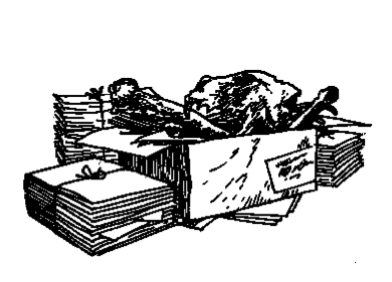At the end of a maze of narrow corridors on the sixth floor of a storage facility on the east side of Manhattan, John Payne, an archival appraiser from Texas, opens a padlocked metal door to reveal a corner room packed with more than a hundred archival boxes of papers once belonging to George Ames Plimpton. At 11″ x 13″, with windows to the south and east (too high to see out of, but affording a dim illumination when the movement-activated lights time out), the room is the facility’s honeymoon suite and is about as large as the editorial office of the Paris Review, where Plimpton edited the magazine until his death two years ago at age seventy-six. Eight-foot metal shelves line the four walls, with three archival boxes side by side on the lower shelves, and up to three-box-high stacks on the top shelves. More boxes, along with two jumbo-sized Tupperware containers, are piled in the middle of the room. The only sound comes from the buzzing lights, and the rustle of someone two aisles over trying to make space for one more ugly painting. Standing at the threshold to this room, one registers an unsettling sense of trespass, as though having intruded on a king’s barrow.
Plimpton’s papers have not always enjoyed such a clean, climate-controlled existence. Until a few years ago, when a Paris Review intern was engaged to box them up and get them into some sort of order, the papers lived in a big dusty pile in the basement of Plimpton’s 72nd Street townhouse. After Plimpton’s death, his widow Sarah arranged to have the papers moved to their current location, where the danger of flooding, mildew, shoddy wiring, vandalism, and damage from vermin was significantly reduced. Now that everything was securely stored, the next task was to figure out what to do with it all. It’s the kind of difficult decision—informed equally by grief and expediency—that every widow or widower must face. But not every widow was married to a famous writer, among whose papers one could expect to find personal correspondence with the likes of Terry Southern, Marianne Moore, Jackie Onassis, and George H. W. Bush, among a host of others. Mrs. Plimpton’s primary option at this point would be to sell the material, either in bits and pieces, at auction, to private collectors, or as a whole to a research institution. In either case, it would first be necessary to estimate the archive’s worth.
The thought that there somewhere exists a dollar amount expressive of the material in this room might not, at first, seem all that unusual. Writers, after all, are always selling their work. But then this...
You have reached your article limit
Sign up for a digital subscription and continue reading all new issues, plus our entire archives, for just $1.50/month.
Already a subscriber? Sign in





